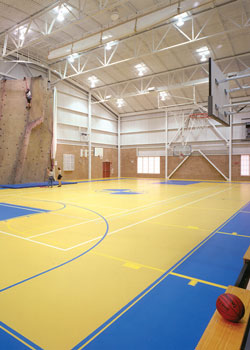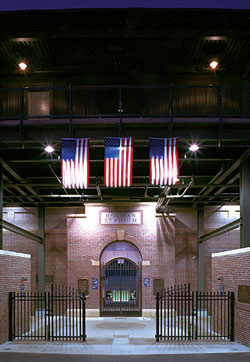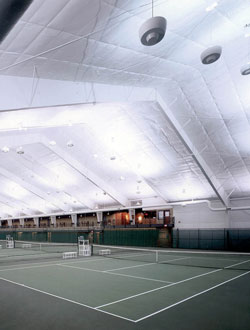Publications
If You Design and Build It…They Will Come
Andrea Murray, AIA, NCARB, LEED APReady to go the distance, sports and recreation clients come to Bread Loaf Corporation hoping we can turn their dreams into reality. They look to us to help them conceptualize, visualize, rationalize and realize their ideal facilities. We do this by getting to know the decision makers, working with them to develop a program, understanding their budget and scheduling requirements, and developing creative solutions to the design challenges that ensue.

Get your head in the game.
Get to know your clients. Who are they? Often they are municipalities, team owners, academic institutions and private resorts. Sometimes one project can have more than one client. For example, Bread Loaf’s work preserving, renovating and adding to historic Holman Stadium, the home of the Nashua, New Hampshire Pride minor league baseball team, involved several clients: the team owners, the team players, the City of Nashua and the local community.
With the exception of our repeat clients, most of have never worked on a design/build project. In fact, the client side of the project team often approaches the design builder with a great deal of skepticism. Not used to design/build delivery methods and initially not certain whether or not we’re the architect or the contractor (of course, we’re both), new clients may approach Bread Loaf with caution as if they’re about to embark on a risky and dangerous endeavor. After all, there is a lot at stake, for them and for us. Fortunately, it doesn’t take long before our clients are won over by our process. They begin to appreciate that our single-source responsibility saves time, allows for flexibility, reduces change orders, eliminates “finger pointing,” and results in the maximum project value for the allotted budget. Educating the client about the design/build team approach can be the most important challenge of the entire project.
At Bread Loaf, we’ve taken traditional design/build one step further. We call our process Integrated Project ManagementSM (IPM). We house planners, architects, estimators, mechanical engineers, project managers, and construction trades under one roof, allowing for a fully integrated and cohesive project team. Our goal is to translate each client’s vision, brand and goals into remarkable spaces while managing design, schedule, budget and risk. The IPM approach works especially well for our sports and recreation clients, because their projects are often constrained by a limited, fixed schedule and a tight budget. So, it’s a race to provide the best possible solutions within the designated timeframe, for a fixed price.
On your mark…get set…go!
There are two types of programs for sports and recreation facilities: single-use and multi-use. Clients usually know which they are likely to pursue, but not always. It might be part of our programming process to help them determine what activities might best suit their needs. More often, however, the client comes to Bread Loaf with one or two ideas as to which activities the facility should accommodate. One service we provide to our clients is an evaluation of many activities in the context of the proposed building type. We can present to them those activities that might share spaces and be accommodated under the same roof, with minimal changes to the original scope of work.
To do this, we might develop a matrix: activities down the side and facility requirements across the top. Bread Loaf used this approach at Landmark College in Putney, Vermont. In May 1999, we began planning for a small multi-use sports facility. The program specified an indoor tennis and basketball court. Both required a similar area, so we researched appropriate surfaces that would accommodate both games in the same space. The spatial requirements for tennis, in particular, were most stringent and determined the height and shape of the gymnasium roof.
On the Landmark College matrix, we looked into various different activities that might also take advantage of either the surfacing or the clear height within the space. Volleyball was a good fit, and a climbing wall was a feature we could introduce at a very low cost, but high value, to the owner. We soon realized that this gymnasium would become the largest indoor gathering space on campus, able to accommodate up to 800 people. The design and installation of air conditioning for this space made it a convenient, comfortable, and appropriate place for large events such as convocation and graduation.

The 16,500 square foot Click Family Sports Center at Landmark College currently houses the tennis, basketball and volleyball court and climbing wall. It also includes a fitness center, velocity exercise pool and support spaces such as locker rooms, offices and a mechanical room. It may surprise you to learn that these features represent only half the client’s original program/wish list. Landmark also wanted its Sports Center to include an indoor running track, an additional tennis court, weight, aerobic and martial arts rooms, and racquetball courts. Given a construction start date of August 1, 2000 with completion in time for graduation in May 2001 (as well as a relatively limited budget), there was neither the time nor the money to build the additional facilities. We did, however, have the foresight to plan for them to be added in the future.
Phasing for sports and recreation facilities is relatively common practice. Clients frequently come to us with a wish list twice the size of their budget. We do our best to help clients prioritize and incorporate more than half their needs into the first phase, and we are careful to design each building so it will continue to function appropriately as the facility grows.
Another planning challenge for the designers of sports and recreation facilities is fitting into the neighborhood surroundings while maintaining the image set forth by the client(s). One planning issue Bread Loaf architects encountered at Holman Stadium was that of appropriate scale. The scale of the existing facility seemed more like that of a dollhouse than what one might expect a minor league baseball stadium to be. Added program elements, including a main concourse and the elevation of a new upper level and concourse for skyboxes, provided for a change in the stadium’s scale that more aptly fits the program. However, the stadium is set in a dense, urban residential neighborhood, and there was always the concern that the stadium might overpower, overshadow the neighborhood. Fortunately, when the original WPA ballpark was constructed in 1937, the designers had the discretion to plant a ring of fir trees around the field. Those trees, now mature, are tall enough to conceal and buffer the field from the surrounding residences, and create a park-like setting. The nearly 70-year-old trees vertically enhance and reinforce the new, larger-scale facility.
So, at this stage in the game, it’s worthwhile to ask some questions. Will the building be a showpiece or a background building? Is it expected to be an advertisement and an attraction? Will this facility welcome the public, or is it private? Answers to these questions will influence the exterior and formal design of the project. Knowing what the owners and the community expect can also help when presenting to local planning and zoning officials. A side note: when introducing a project to local officials, be sure that you are fully prepared to address added noise and traffic that the new facility will generate.
Regardless of the type of facility, single-use or multi-use, it is paramount to plan for the spaces that will support the priority sports and recreational activities. Locker rooms, mechanical rooms, lounges, food service, ticketing, offices and circulation spaces are often overlooked or set aside for later attention. Don’t do it! Plan for them up front, and do the planning as well as possible based on any future expectations for expansion of the facility. It is easy to budget and schedule for these spaces early in the project. It can be extremely painful to try and retrofit for them later on. That said, the project and process must also be flexible—within reason. Due to the fast-track nature of sports and recreation facilities, there are bound to be features forgotten. When they crop up during construction, or whenever, the design, budget and schedule must be able to accommodate them.
Show me the money!

While budgets for sports and recreation facilities are often fixed, they can also be extremely volatile, unpredictable and inconsistent. It is especially important for the design builder to know the sources of funding for a project. This will help the team plan better. Budgets are frequently tied to design, scheduling and construction requirements…if this, then that. Be aware, and be wary of all preconditions. Sometimes it’s a matter of confirming the intent of the design or submitting proof of a designed and built condition. At other times, it might mean satisfying a donor’s personal preference, which may or may not be a recommended professional practice.
Typically, sports and recreation projects are funded in three ways: by donor, bond vote, or economic modeling to predict corporate cash flow.
The most difficult issues Bread Loaf struggles with in terms of budgeting for sports and recreation projects are: Where do we spend the money? And, what is the appropriate balance of quality and value? The Avanyu Spa and Pool at the Equinox Hotel in Manchester, Vermont was one Bread Loaf project that was primarily budget-driven. The project was considered both an independent spa and amenities for hotel guests. The marketing studies and economic modeling determined the program for this facility. It included an indoor pool, spa treatment rooms, a movement studio, an exercise room, manicure room, locker rooms and saunas. By predicting the potential cash flow that would be generated from these added facilities, the owner was able to designate an appropriate budget for the project. That said, the design was all about marketing: make the facilities as attractive as possible, without skimping on building systems.
Run like the wind.
Schedule is another big obstacle for the sports and recreation project team. Most of the time these projects race along on an extremely fast pace, to meet the scheduling demands of sports seasons and/or academic schedules.
What can we do to keep things on track? Don’t commit to a schedule that you can’t maintain. Add some extra buffer to your schedule for unforeseen conditions, i.e., owner’s design decisions, permitting, weather, delivery delays, code issues, etc. Keep the entire team informed about scheduling constraints. Brainstorm together to discover creative ways to minimize impact on the project schedule. Examples: research materials with the shortest lead times; specify systems that can be manufactured off site and installed as needed; sensitively schedule any disruptive construction activities; and so on. Most project managers have a good handle on how to do this; the point is that the scheduling process must integrate the entire team, including the owner, from the beginning and throughout the project.
Curve Balls
As mentioned earlier, deciding where to spend the money can be an arduous task, a never-ending balancing act of quality and value. Due to the expansive and expensive nature of most sports and recreation facilities, the tendency is to focus on structure, mechanical systems, playing surfaces, acoustics and lighting. Often, a budget for architectural detailing is not a set priority. Be creative, and don’t neglect the need to develop various elements of the project for desired effect.
It’s not as simple as saying, “put an expensive carpet here and a cheap one there” or asking whether you want “a built-in reception desk or a card table?” The challenge is to determine where we can get the biggest bang for our buck, and then to design creatively to minimize expensive detailing while maximizing effect. The Alexis Boss Tennis Center and Alan Gordon Pavilion at Dartmouth College in Hanover, New Hampshire is a good example of how we creatively allocated monies to enhance the perception of the overall facility. The main entrance to the facility is from a promenade bridge that flanks the building and adjacent playing fields. The bridge brings visitors and players into the building lobby on the second story, where a balcony offers an impressive view down onto the six brilliantly lit indoor tennis courts. The entry/lobby features a comfortable, wood-paneled seating area that also acts as a dedication space for the entire pavilion. Also in this area is a finely crafted reception desk and display. Note that the entry/lobby of this building is incredibly small compared to the overall expanse of the courts and other associated spaces. But, it is from this place that visitors and players first see the facility, so the initial impression is one of significance.
The balcony of the Tennis Pavilion, which extends from the lobby area for the entire length of the building, creates a wonderful spectator opportunity. The railing design was essential to the success of this space. We took a rhythmic cue from the building structure and used the huge columns to anchor the railing in each bay. If we had designed a traditional guard rail at 42” with balusters every four inches, we would have disrupted the view for seated spectators. Instead we developed an interesting detail where the metal rail stops at 26” above the balcony floor, and clear glass completes the guard to 42.” In addition, we specified comfortable barstool-type seating that raises the seated spectator above guard. The overall effect is considerate, but not intrusive.

Let not all this talk of architectural detailing overshadow the primary purpose of Dartmouth’s Pavilion: tennis! The six courts were built with a custom synthetic playing surface, and lighting, ventilation and acoustics were a major focus. When we were given performance guidelines for the mechanical systems, they included a requirement that the systems create noise, which in effect, would be no louder than the rustling of leaves.
Building systems, while not usually flashy and eye-catching, are of the utmost importance to all sports and recreation facilities. Such systems include: mechanical, heating and ventilating, electrical and lighting systems, plumbing, fire protection and, to some extent, structural and envelope design. No sports or recreation facility depends more on all of these systems than the indoor pool. At the Avanyu Spa, handsomely crafted timber trusses span 48 feet, allowing for a 48 foot wide by 90 foot long clear open space for the pool. The extensive use of glass in the pool area brings the outside in, helping to create an even more expansive, light-filled space. As a result of these features and the very nature of the facility, the project had its share of system design challenges, with humidity control, ventilation and heating, and envelope design at the forefront. While there certainly are creative solutions for the design of such systems that will not cost an arm and a leg, it is critical to address these issues at the onset of this type of project. Systems as an afterthought can have a considerable negative impact on all other aspects of the project.
Photo Finish!
On time, on budget, happy client, what more could we ask?
Fast-track, tight-schedule projects often mean that some aspects of the project have not been completely thought out. The very nature of Bread Loaf’s IPM process, an intensive presence and overlap of design and construction, helps to minimize these situations as well as the number of warranty issues that could arise. While we strive to eliminate warranty issues for our projects, it is difficult to do, given tight time and budgeting constraints - be sure that there will always be something that needs fixing.
Clients need to be made aware of the limitations and pressures inherent in their projects. Let them know that although the team will do its best to avoid them, there may well be warranty issues. Let them know that the team will give immediate and intensive attention to those issues. Let them know that you are as proud of the project as they are, and that you want it to perform as designed for years to come. And finally, let them know that you look forward to working with them again.
-
Realizing the Client’s Vision : Design-Build Creates A Landmark for Orvis
Bread Loaf Corporation
Manchester, VT — When the Orvis Company decided to locate its flagship retail store in Manchester, it was adamant that its new facility would be far more than just an attractive new store. Orvis wanted the building and its...
-
Partnering with Small Colleges to Envision the Future
Andrea Murray, AIA, NCARB, LEED AP
Achievement, Opportunity, and Growing Pains The list of challenges plaguing small college presidents and administrators these days is significant, with the rising cost of doing business, shrinking endowments (if any), and sustained pressure to grow and compete for...
-
Small Town Justice - Focus on Local Police Facilities
Andrea Murray, AIA, NCARB, LEED AP
Government spending at the Federal, State, and local levels for policing and public safety has risen significantly in recent years. A more security-conscious society and concern for drug-related crimes are leading to an increased need for services. Employment...
-
Design-Builders to the Rescue
Andrea Murray, AIA, NCARB, LEED AP
Our Ailing Planet By now, we all realize our planet is ailing and our climate is extremely unstable. The evidence for global warming and related climate change is considerable. We also recognize that this new type of climate...
-
The Little Green Book
Bread Loaf Corporation
Confused about all this talk about Green Building? Let us break it all down for you. This book takes a look at sustainable design and construction and highlights the strategies and benefits of Green Building.
-
Healthy Building = Healthy People
by Andrea Murray, AIA, NCARB, LEED AP
Health Care and Rehabilitation Services of Southeastern Vermont (HCRS) is a multifaceted, non-profit, community mental health agency which has served Vermonters since 1967. By 1990, the agency had evolved into the comprehensive human services provider it is today with major...
